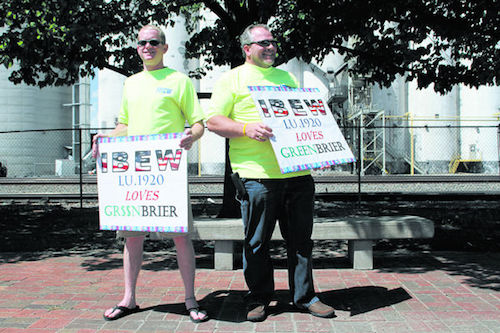New bargaining units in the IBEW’s railroad branch are rare. U.S. freight and passenger carriers are already union dense. While some smaller commuter carriers have been organized, big opportunities can be opened up at some of the companies that manufacture and service rail equipment.
Last year, 30 manufacturing workers at Greenbrier Rail Service in Hershey, Neb., voted to join North Platte Local 1920. Greenbrier’s factory produces wheel and axle sets for freight trains. At the time, the Local 1920 bargaining unit was the first at the company’s U.S. holdings. Greenbrier maintains collective bargaining agreements at plants in Poland and Mexico.
“Conditions were pretty rough. There wasn’t a lot of respect at Greenbrier,” says Local 1920 Chairman Mike Thiessen, who heard about problems at the facility from a friend. Thiessen got in touch with a few Greenbrier employees, established a volunteer organizing committee and, only two weeks later, obtained union authorization cards from 70 percent of the eligible workforce.
Negotiations on a first contract began in December and concluded in April. A new agreement was ratified in June.
“The talks went very well. We won some good points. So did Greenbrier, but they were very open and direct,” Thiessen says.
The agreement includes a progressive wage scale providing for healthy bonuses in return for productivity improvements. Workers won an extra holiday and a change in scheduling that allows them more time with their families around Christmas and New Year’s.
 |
| Following four months of negotiations, members of North Platte, Neb., Local 1920 who work for Greenbrier Rail Service ratified their first contract in June.
|
The most important gain, says Thiessen, is the establishment of a grievance and arbitration procedure and a just cause clause. Greenbrier workers still talk about a text message management sent to all employees on a Friday night before the union vote where they threatened to “kick their ass” if employees didn’t meet the plant’s goals the next day.
Thiessen, who started out as a construction electrician in Omaha Local 22, says, “Like other journeymen inside wiremen, I complained about the International union without seeing firsthand how reps and directors serve the membership.”
“We had tremendous support from [the] Membership Development Department,” Thiessen says. Often, organizers would drop in unannounced at meetings with prospective members. “It kind of opened my eyes to the whole IBEW.”
Most members are very satisfied with the first agreement, Thiessen says. There will be “growing pains” as Greenbrier workers integrate into the local union and managers and members establish new relationships, but members are hopeful about the future.
“It helped our campaign and first contract negotiation to have so much support from Membership Development,” says Thiessen. “It supported our message that folks were joining the most powerful union on the planet.”
The IBEW has active organizing campaigns underway at other Greenbrier locations in the U.S.
Photo from Wikimedia Commons user Slambo.